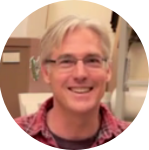About This Project
The Burke Museum received a mysterious ceramic vessel, a large clay jug believed to be Chinese in origin. What's inside? Let's find out!Ask the Scientists
Join The DiscussionWhat is the context of this research?
The Burke Museum received a mysterious ceramic vessel, a large clay jug believed to be Chinese in origin. How old is it? Where did it come from? And what’s inside? Researchers at the Burke are attempting to solve this mystery and maybe even discover something amazing in the process.
What is the significance of this project?
Made of clay and sealed watertight, the “vessel” was found on the shore of North Cove in Grayland, Washington. It was discovered in 2003 by Steve Sypher, but over 7 years passed until the Sypher family brought the vessel to the Burke in 2011. Once it was brought to the Burke Museum Professor Stevan Harrell, an Anthropologist at UW, noticed two Chinese symbols stamped on the vessel. One of those symbols translates to ‘Sheng,’ which means ‘To Rise.’ Professor Harrell was stumped. Mailing a colleague at a maritime museum in China to get a second opinion, Professor Harrell’s colleague suggested the vessel isn’t a southeastern Chinese (Fujian) pot, but that it might come from a kiln in northern China instead.
What are the goals of the project?
The first step will be to have this vessel x-rayed. If the contents appear to be residual foodstuffs, a small sample will be extracted through a small hole drilled from the base of the vessel for chemical analysis using mass spectrometry. Also, when was this vessel made and how long has it been floating in the Pacific? Typological research will be conducted as part of the literature review and in collaboration with international colleagues to answer these questions. If these approaches do not yield a date, we will potentially use thermoluminescence dating. This is a destructive process, requiring the removal of some of the vessel (5 mm thick and 3 cm in diameter).
We want to know if was this vessel used for food, water or other liquid storage? Was it used in trade, as a container for a ship’s crew or some other use? Content analysis and the collaborative research conducted by the UW archaeology graduate student will provide answers. Also, how did this vessel get to the Washington coast? How can this artifact contribute to our understanding of ocean currents? We will be consulting with the oceanography department to aid in this research.
Budget
We propose hiring a UW archaeology graduate student to conduct an extensive literature review and contact archaeologists and ceramic experts in China, Japan, Taiwan and Southeast Asia. A UW archaeology graduate student will also conduct x-ray fluorescence (XRF) analysis to determine elemental composition of the vessel body and the separate seal cap. Once potential locations are identified, the XRF data will provide specific details to pinpoint the manufacture location.
Meet the Team
Affiliates
Team Bio
Peter Lape is an Associate Professor in the Department of Anthropology and Curator of Archeology at the Burke Museum of Natural History and Culture at the University of Washington. He earned his Ph.D. from Brown University.Peter Lape
Peter Lape is an Associate Professor in the Department of Anthropology and Curator of Archeology at the Burke Museum of Natural History and Culture at the University of Washington. He earned his Ph.D. from Brown University.
Laura Phillips
Laura Phillips is the Archeology Collections Manager at the Burke Museum of Natural History and Culture at the University of Washington. She earned her M.A. in Museology from the University of Washington and holds a B.A. in Anthropology from Colorado College.
Project Backers
- 19Backers
- 0%Funded
- $0Total Donations
- $14.79Average Donation

